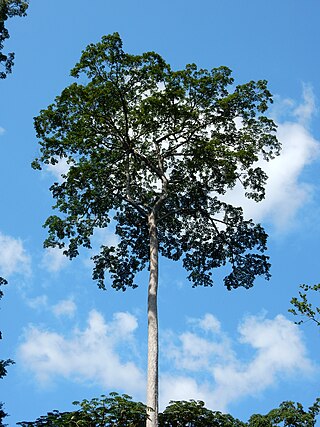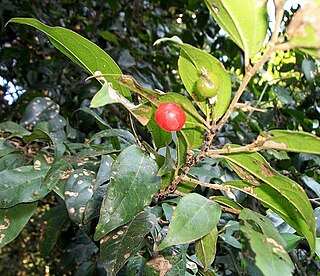
Celtis is a genus of about 60–70 species of deciduous trees, commonly known as hackberries or nettle trees, widespread in warm temperate regions of the Northern Hemisphere. The genus is part of the extended Cannabis family (Cannabaceae).

Chrysophyllum is a group of trees in the Sapotaceae described as a genus by Linnaeus in 1753.

Zanthoxylum is a genus of about 250 species of deciduous and evergreen trees, shrubs and climbers in the family Rutaceae that are native to warm temperate and subtropical areas worldwide. It is the type genus of the tribe Zanthoxyleae in the subfamily Rutoideae. Several of the species have yellow heartwood, to which their generic name alludes. Several species are cultivated for their use as spices, notably including Sichuan pepper.

Myrica is a genus of about 35–50 species of small trees and shrubs in the family Myricaceae, order Fagales. The genus has a wide distribution, including Africa, Asia, Europe, North America and South America, and missing only from Australia. Some botanists split the genus into two genera on the basis of the catkin and fruit structure, restricting Myrica to a few species, and treating the others in Morella.

Schinopsis balansae is a hardwood tree known as willow-leaf red quebracho which forms forests in the subtropical Humid Chaco ecoregion of north-eastern Argentina, and Paraguay. It is also found in the wild Pantanal vegetation in Brazil. Some of its vernacular names are quebracho colorado chaqueño and quebracho santafesino. Other species, like Schinopsis lorentzii, bear the general name quebracho and have similar properties and uses. S. balansae shares its habitat with a species of the same genus, S. heterophylla, and the two are often confused.

Terminalia superba, the superb terminalia, limba, or afara (UK), korina (US), frake (Africa), African limba wood, ofram (Ghana), is a large tree in the family Combretaceae, native to tropical western Africa.

Lasiodiscus, commonly known as red-hair bushes, is a small plant genus in the family Rhamnaceae. It is endemic to Africa and its adjacent islands.

Sorindeia is a genus of some three dozen plant species that are native to tropical Africa, Madagascar, the Comoro Islands and Mascarene Islands. They are distinguished by their compound leaves, large inflorescences and distinctive fruit. In the case of S. madagascariensis, as many as 200 fruit may be carried on a pendant cluster.

Dracaena fragrans, is a flowering plant species that is native throughout tropical Africa, from Sudan south to Mozambique, west to Côte d'Ivoire and southwest to Angola, growing in upland regions at 600–2,250 m (1,970–7,380 ft) altitude. It is also known as striped dracaena, compact dracaena, and corn plant.

Buchanania obovata is a small to medium-sized understorey tree in woodlands native to northern Australia, in particular in Arnhem Land in the Northern Territory. Common names include green plum and wild mango.

Celtis mildbraedii is a species of forest tree in the family Cannabaceae. It was previously assigned to the family Ulmaceae. These trees grow in limited areas of South Africa, Mozambique and Zimbabwe. They are also found in forested areas from West Africa to Sudan, DRC, Angola and Tanzania. Common names include natal white stinkwood, red-fruited white-stinkwood and natal elm. This species is more common in Tropical Africa than in Southern Africa.

Cola is a genus of trees native to the tropical forests of Africa, classified in the family Malvaceae, subfamily Sterculioideae. Species in this genus are sometimes referred to as kola tree or kola nut for the caffeine-containing fruit produced by the trees that is often used as a flavoring ingredient in beverages. The genus was thought to be closely related to the South American genus Theobroma, or cocoa, but the latter is now placed in a different subfamily. They are evergreen trees, growing up to 20 m tall, with glossy ovoid leaves up to 30 cm long and star-shaped fruit.

Cryptocarya woodii, the Cape quince, is a shrub or small forest tree, native to southern and eastern Africa. Its Latin name commemorates John Medley Wood, a botanist in Natal. From mid summer the tree bears small, inconspicuous flowers. The ripe fruit have a bumpy surface and are shiny, purple-black in colour. When a leaf is viewed against light some minute secretory glands are visible in the vein polygons (areolae). The larvae of Papilio euphranor and Charaxes xiphares breed on the foliage of this tree.
The Bugoma Forest is a protected tropical forest that is situated southwest of Hoima and northeast of Kyenjojo towns, and east of Lake Albert, in the Hoima district of western Uganda. It was gazetted in the 1932 and came under the mandate of the National Forestry Authority in 2003. But it was expanded in 1965, 1968 and 1998. Its surface area is given as between 41,144 hectares (411.44 km2) and 65,000 hectares (650 km2).
Lasiodiscus fasciculiflorus is a species of shrub or small tree in the family Rhamnaceae that is native to forests of the West African tropics. It occurs from Sierra Leone to Nigeria and the D.R.C. The bark is used in medicine to treat various ailments.
Xylopia staudtii Engl & Diels is a tall tree within the Annonaceae family, it can grow up to 50 meters tall, the tallest height of the African Xylopia trees. It occurs in forest and freshwater swamps in West Africa.

Alstonia congensis, is a tree within the Apocynaceae family and one of two African species within the Alstonia genus, the other being the Alstonia boonei De Wild. Both have similar morphological characteristics.
Annickia polycarpa is a small to medium-sized tree found in evergreen forests of West and Central Africa, it is within the Annonaceae family. It is also called the African Yellow wood.
Lannea microcarpa is a dioecious plant within the Anacardiaceae family. It is also called African grapes and occurs in the Sudan and Guinea savanna of West Africa from Senegal to Cameroon. The plant is used to dye basilan fini, a traditional cloth in a red and brown colour.
Lannea schweinfurthii is a small to medium sized deciduous tree within the Anacardiaceae family. The tree is sometimes called 'bastard marula' or 'false marula' because when it is without flowers or fruits, it become quite similar to the marula tree and sometimes confused for the marula tree. Extracts of the species is used in traditional human and veterinary medical practices.















